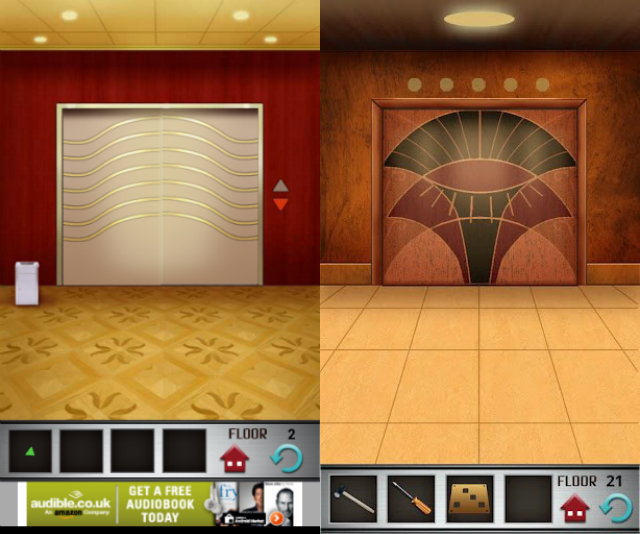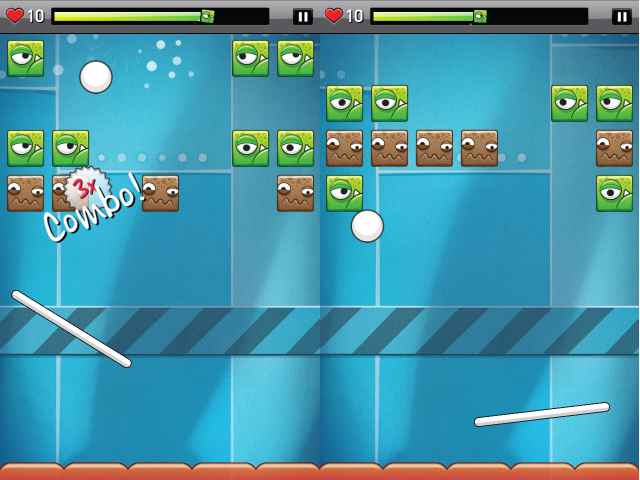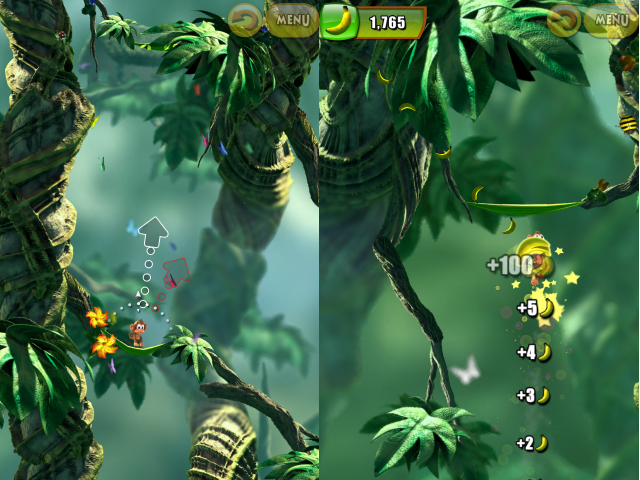Mobile Monday – Split Decision, 100 Floors, Draw Breaker, Chimpact
You know what day it is? It’s Monday again and that can mean only one thing here at GodisaGeek.com: It’s time for another edition of Mobile Monday, the article where we take a look at four mobile games and let you know if they’re worth your time and money.
This week we’re taking a look at Split Decision from Dennis Media Factory, 100 Floors from Tobi Apps, Draw Breaker from Elevate Entertainment LLC and Chimpact from Yippee Entertainment.
Read on to find the full reviews of each game, but don’t forget to come back next week for more Mobile Monday reviews. While you’re here, if you have played any of the games listed, or even just want to come back once you’ve had a go to let us know how you got on, we’d love to hear from you in the comment box at the bottom of the page.
Get downloading and get playing!
Titles are available on iPhone and iPad unless specifically stated otherwise. If you like what you read, click the small black “App Store” button to load iTunes up and purchase the title!
![]() SPLIT DECISION:
SPLIT DECISION:
People often like to test their knowledge, whether that’s doing the daily crossword puzzle in the local paper, or downloading an app on their mobile device. Seeing as this article is called ‘Mobile Monday’ and not ‘Monday Crosswords’, the chances are good that we’re going to be talking about the latter. The game in question is Split Decision, a quick-fire question and answer game that not only tests your knowledge, but also how quickly you can input the answer into the game. Panic and get the wrong answer and you’ll be lowering your overall percentage, which isn’t something you want to do. Split Decision is developed by Dennis Media Factory and could prove to be an addictive little game if you’re the type of person who enjoys testing their intellect in short, speedy bursts.
The main aim of the game is to select a series of cards that are based on certain topics and answer questions on that topic as quickly as you can. What makes the questions even more difficult is that fact that both of the answers often seem correct at first glance, so even though the whole aim of the game is to answer as quickly as possible, you’re still going to want to give yourself a second or two to accurately read what the possible answers are. Skimming over them and not reading them properly is a sure-fire way to fail the game.
There are a couple of game modes available to you: Quick, where you have a set amount of time on the clock and you’ve got to answer as many questions as you can before the counter reaches zero, Deadly, where you have three lives to answer as many questions as you can but you’ve got an unlimited amount of time in which to do so. Finally – by far the most fun mode – we have Challenge mode where you have to test your intellect against a series of great minds through history. The comedy value of the game really shines through in this mode as the historical figures will try to put you off of your game at the start of each round by shouting things at you; all in good fun of course.
If you can move quickly enough then the controls are extremely fluid and simple, you’re only ever given two choices for the answers to each question so you’re never overwhelmed with items on the screen. The only people that may have a problem controlling and playing the game are the people that don’t normally play games on their smartphone. Perhaps you’ve passed over your phone to a parent or grandparent, at that point, the speed that you’re required to play the game at in order to succeed could present a small issue. That’s not really the game’s fault though.
Split Decision is an amazingly addictive game, the design is simple and that really works for the game. The player will never feel overwhelmed by the items that are on the screen and most players that spend time in the game will keep playing, being overcome by the “just one more go” nature of the game. If you want a game that allows you to quickly and easily test your knowledge then you could do much worse than Split Decision.

![]() 100 FLOORS:
100 FLOORS:
100 Floors is a game that’s been out for the Android devices for a while now, so it’s about time we took a look at the puzzle game that everyone’s been going on about. Developed by Tobi Apps, 100 Floors is exactly what it says on the tin: 100 Floors of puzzles. You have to solve the single puzzle on each of the floors in order to advance to the next one, so there’s nothing particularly complex about it (not the concept anyway, the puzzles themselves are a different matter) but it’s damn addictive.
You’re blocked from getting onto the lift by a series of different puzzles, one per floor. Some of them may have the button missing and you’ve got to tap around the screen in order to find it, some may have a particular object you’re supposed to find before you can move forward, others may require you to think outside the box a little bit, moving the phone in certain ways, for example. As far as puzzle games go, despite its simple aesthetic and gameplay mechanic, 100 Floors utilises some truly unique puzzle mechanics to keep you interested. You’ll hear yourself saying “I’ll just see what this next floor is like” over and over again until you realise that it’s four hours later and you haven’t finished anything you promised people you were going to do. Such is the nature of addictive puzzle games.

There’s nothing else to 100 Floors really, there are no other modes and nothing that will keep you wanting to play after you’ve completed all of the game’s levels. Unless of course you feel the need to challenge yourself. You could create your own little game where you compete with yourself to complete all 100 floors of the game in the fastest time possible, or maybe the developers will come up with a leaderboard system or some other reasons to continue playing the game.
The hardest thing about the controls for 100 Floors is actually being able to press on some of the objects that you’re required to in order to finish the levels. I came across a few situations where I knew what I needed to do in order to complete the puzzle, but the game wasn’t recognising the taps of my finger, or I wasn’t able to do it accurately enough on the Android phone I happened to be using. Either way it was the main point of frustration in the entire game especially as you’re not given any indication if what you’re doing is correct anyway.
Due to the fact that 100 Floors is so visually simplistic (in a good way) it loads quickly on just about any Android phone out there, couple that with the fact that the levels themselves are quick (providing you can figure them out) and you’re left with a game that’s almost a perfect pick-up-and-play game while you’re waiting at the bus stop, waiting for the kettle to boil or anything else that you might have five minutes to spare. The game is free too, so there’s no reason for you not to at least try it out, even if you ultimately find yourself frustrated by the controls often requiring extremely specific screen touches. 

![]() DRAW BREAKER:
DRAW BREAKER:
The title of a game can often give the whole game away; you’ll take a single glance, decide for yourself what the game entails and decide whether or not you’re going to bother downloading and playing it. When Draw Breaker, developed by Elevate Entertainment LLC, dropped onto the Mobile Monday desk I was going through those same motions, trying to figure out from the name, and the icon, what the game was going to be before I’d even loaded it up for the first time, but I was totally wrong. Draw Breaker is similar to the standard Breakout clones that we’ve seen before but with a couple of differences that make it a totally unique gaming experience.
The gameplay in Draw Breaker revolves around clearing the screen of all the blocks that are coming down from the top of the screen. If they reach a certain point and they stay in that area of the screen for an extended period of time, then its game over and you’re going to have to try it all over again. The objective of each level is to clear the screen using the ball that you’re able to bounce around the screen. Some of the “enemies” take only a single hit to clear them while others require a little bit more skill and finesse. That’s where the major change of Draw Breaker comes in, something that sets it so far away from other Breakout clones that it’s almost in a genre of its own.

Instead of having a platform at the bottom of the screen that you can move around as you wish, your objective is to draw your own platform using your finger on the iOS device’s screen. The ball will react to the platform in a way that you would expect, depending on how you’ve drawn it. If you need the ball to go towards one of the sides of the screen, draw a diagonal platform. Want it to go straight back up? Then a platform that goes from left to right is probably what you’re looking for. As mentioned, the gameplay is different enough to keep you interested in the game for the long-term but it’s similar enough to get a good number of people interested in the game in the first place.
The controls of Draw Breaker are easy to learn, but on the later levels they’re truly difficult to master. On some levels (and when you pick up some particular power-ups) you’ll have to attempt to juggle multiple balls flying around the screen at once. This is often difficult enough when you’ve got a fixed platform that you just have to move around quickly enough, but add the fact that you’ve got to draw your own platform and you’re left with a game that you could love or hate based on whether you’re quick enough to draw the platforms.
If you’re a fan of good Breakout clones and you’ve had your fill of the more traditional ones, then you should absolutely give Draw Breaker a chance. It’s a nice change of pace from the games that we usually see and the ability to draw your own platforms will get most players invested in the game to a level that they’re not used to; in a good way, of course. 

![]() CHIMPACT:
CHIMPACT:
Games with funny titles automatically arouse my interest, there’s just something instinctual about it, seeing a funny named iOS game and just assuming that I’m going to have a good time while playing it. Unfortunately, that’s not always the case. There are instances where I’ve downloaded games, some to review, some not, fully expecting to be blown away by what I got only to find out that the icon and the name of the game was just about the best thing about the whole experience. Chimpact is one of those games where the name of it makes me laugh, but is the game (developed by Yippee Entertainment) also one of those games where the name is the best aspect of the whole package?
The aim of the game is to use your chimp to get to the top of the tree, collecting as many gems as you can along the way. Throughout your time with the game you’ll be using plenty of different mechanisms in order to get your way to the top, from vines that you’ll be able to pull downwards and slingshot your monkey, to springy flowers that launch you across the map. At the start of the game things will be fairly straightforward, and you can even jump into the game without even looking at any instructions or reading any tutorials, you’ll soon get the hang of the game. A couple of levels later though, and you’ll find that Chimpact becomes quite a difficult little game, becoming a little bit addictive in the process too.

There are two main game modes that you’ll be spending most of your time playing during your time with the game. The first of these modes, Gem Quest, requires you simply to get to the top of the tree using any means necessary and collecting anything that you can get your hands on, be it gems, bananas or something else. This mode alone has plenty to do and will ensure you continue playing the game long after you think you would have normally stopped. In this second mode, Totem Trial, you’ll be given a series of tasks to complete in order to complete the levels. Essentially they boil down to challenges that you must test yourself with, and there are plenty of those to look into too. For the amount of gameplay you get when you download the game for the first time, you’re getting some incredible value for money.
Chimpact is a quirky little game, and it’s pretty much in a genre all on its own. The animations are impressive and run fluidly on the iOS devices and the assets that are used for the characters themselves wouldn’t look out of place on an Xbox LIVE Arcade game. There’s plenty to see and do for your money and you’ll be playing the game long after you thought you would be, so if you’re looking for a game to take your mind off of your morning commute, or just want something new to play but want to make sure you get your money’s worth, then you should give Chimpact a go. 





